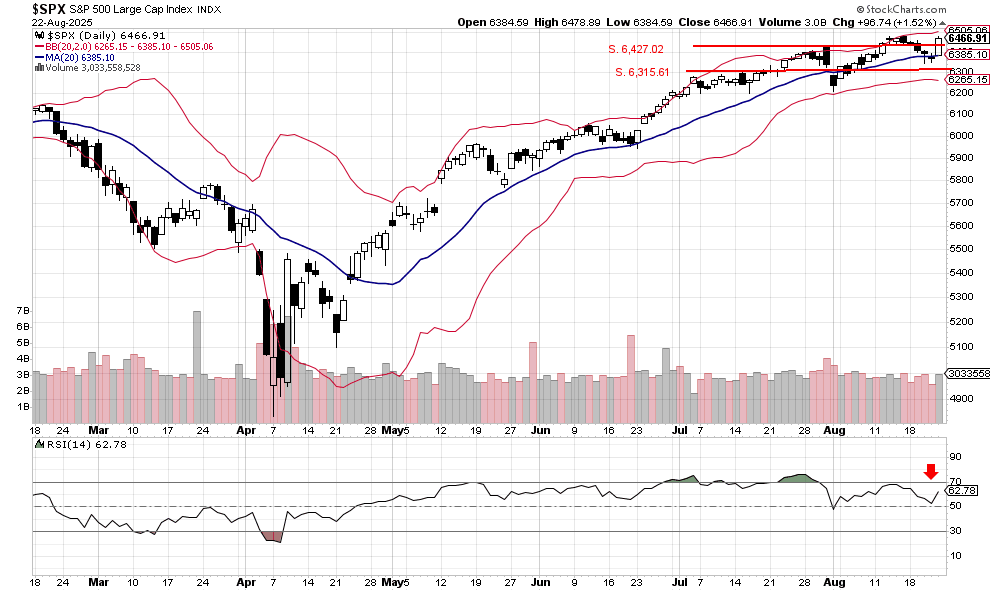Morning Brief

Headline News:
The stock market is on track for a modestly lower opening after an impressive Friday rally that largely neutralized losses from earlier in the week.
Fed Chair Powell’s dovish tone at the Jackson Hole Symposium prompted a rate increase cut expectations on Friday that saw stocks advance, with small-cap stocks performing exceptionally well.
Mega-cap tech names had several bumpy sessions last week that weighed down the major averages until Friday’s rally. Mega-cap performance will be closely watched this week as the world’s largest semiconductor company reports its earnings on Wednesday after the close.
The market will also receive earnings reports from several larger retailers throughout the week.
Today’s economic data is limited to the 10:00 ET release of New Home Sales data. Friday brings about the Personal Income and Outlays report, which includes the PCE Price Index, one of the Fed’s preferred inflation gauges.
Headlines are relatively quiet elsewhere, though NBC News reports that Vice President JD Vance said in an interview that he is optimistic the U.S. can broker an end to the war between Russia and Ukraine.
(Michael Gibbs, Managing Director, Lead Portfolio Manager )
Markets:
The S&P 500 rallied sharply, closing at 6,466.91 and breaking above the resistance line at 6,427.02. Momentum indicators confirmed the move, with the RSI finishing higher at 62.78. Breadth was strong as well, with up volume accounting for 91% of total trading activity—a potential signal that a new uptrend may be underway.
This morning, however, S&P 500 futures are down 0.31%, suggesting some short-term profit-taking after the breakout. On the upside, near-term resistance sits at 6,481.34, while initial support is at the 20-day moving average near 6,385.10.
We are currently Intermediate-term bullish and short-term bullish.

John N. Lilly III CPFA
Accredited Portfolio Management Advisor℠
Accredited Asset Management Specialist℠
Portfolio Manager, RJFS
Partner, DJWMG
Windsor Wealth Planners & Strategists
Futures trading is speculative, leveraged, and involves substantial risks. Investing always involves risk, including the loss of principal, and futures trading could present additional risk based on underlying commodities investments.
The Relative Strength Index (RSI), developed by J. Welles Wilder, is a momentum oscillator that measures the speed and changes of price movements.
The percentage of stocks trading above a specific moving average is a breadth indicator that measures internal strength or weakness in the underlying index. The 50-day moving averages are used for short-to-medium-term timeframes, while the 150-day and 200-day moving averages are used for medium-to-long-term ones. Signals can be derived from overbought/oversold levels, crosses above/below 50%, and bullish/bearish divergences.
The Dow Jones Industrial Average (DJIA), commonly known as “The Dow,” is an index representing 30 stocks of companies maintained and reviewed by the editors of the Wall Street Journal. The Russell 2000 Index measures the performance of the 2,000 smallest companies in the Russell 3000 Index, which represents approximately 8% of the total market capitalization of the Russell 3000 Index.
The S&P 500 is an unmanaged index of 500 widely held stocks that is generally considered representative of the U.S. stock market. Past performance may not be indicative of future results. Keep in mind that individuals cannot invest directly in any index, and index performance does not include transaction costs or other fees, which will affect actual investment performance. Individual investors’ results will vary. Opinions expressed are those of the author, John N. Lilly III, and not necessarily those of Raymond James. “There is no guarantee that these statements, opinions, or forecast provided herein will prove to be correct. “The information contained was received from sources believed to be reliable, but accuracy is not guaranteed. Investing always involves risk, and you may incur a profit or loss. No investment strategy can guarantee success. The charts and/or tables presented herein are for illustrative purposes only and should not be considered as the sole basis for your investment decision. International investing involves special risks, including currency fluctuations, different financial accounting standards, and possible political and economic volatility. Investing in emerging markets can be riskier than investing in well-established foreign markets.
This is not a recommendation to buy or sell any company’s stock mentioned above.
US government bonds and treasury bills are guaranteed by the US government and, if held to maturity, offer a fixed rate of return and guaranteed principal value. US government bonds are issued and guaranteed due to the federal government’s timely principal and interest payment. Bond prices and yields are subject to change based on market conditions and availability. If bonds are sold prior to maturity, you may receive more or less than your initial investment. Holding bonds to term allows redemption at par value. There is an inverse relationship between interest rate movements and bond prices. Generally, when interest rates rise, bond prices fall, and when interest rates fall, bond prices generally rise.
The Nasdaq 100 (^NDX) is a stock market index made up of 103 equity securities issued by 100 of the largest non-financial companies listed on the NASDAQ. It is a modified capitalization-weighted index. It is based on exchange and not an index of U.S.-based companies.
The Russell 2000 Index is a stock market index that measures the performance of the 2,000 smaller companies included in the Russell 3000 Index. It is managed by London’s FTSE Russell Group and is widely regarded as a bellwether of the U.S. economy because it focuses on smaller companies that focus on the U.S. market.



